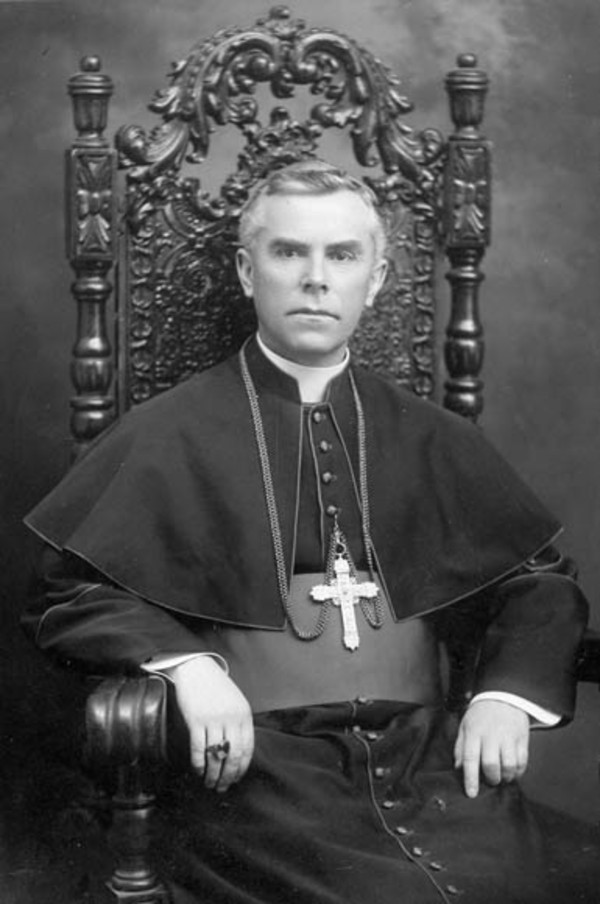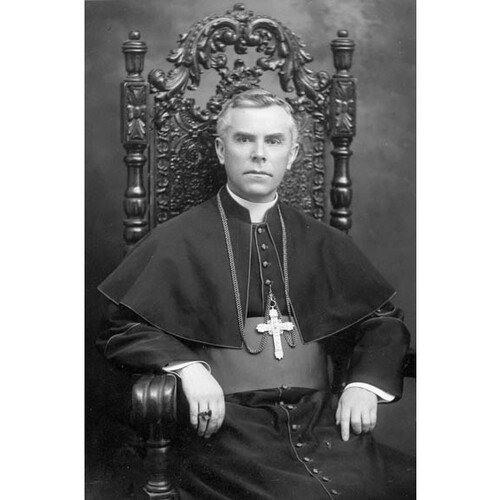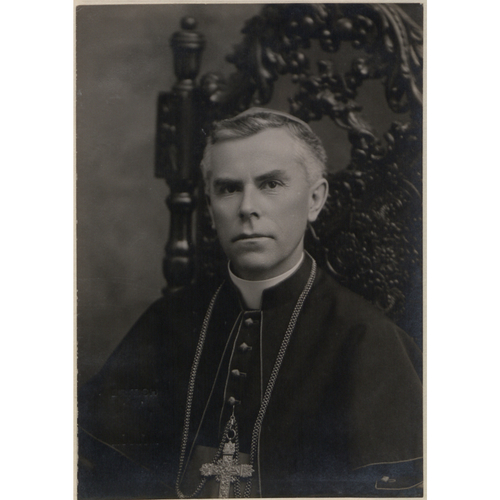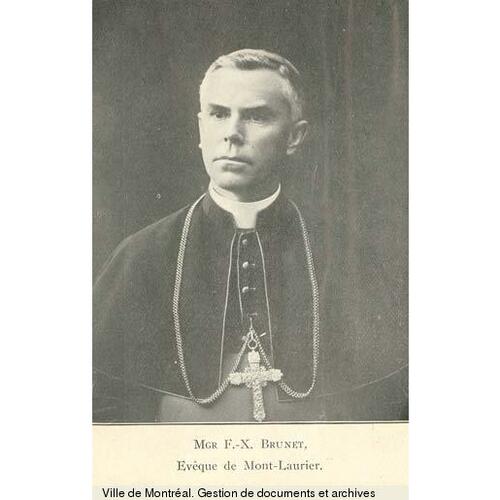As part of the funding agreement between the Dictionary of Canadian Biography and the Canadian Museum of History, we invite readers to take part in a short survey.
BRUNET, FRANÇOIS-XAVIER, priest and bishop; b. 27 Nov. 1868 and baptized two days later in the parish of Saint-André-d’Argenteuil, Que., son of François Brunet and Léocadie Joly; d. 7 Jan. 1922 in Montreal.
In 1873 François-Xavier Brunet’s parents settled in Ottawa, where his father worked as a carter. François-Xavier received his elementary education from the Brothers of the Christian Schools and did his commercial and classical studies at the College of Ottawa, graduating with a ba in 1890. He then decided to enter the priesthood and studied theology at the Grand Séminaire d’Ottawa. On 23 Sept. 1893, at the age of 24, he was ordained by Archbishop Joseph-Thomas Duhamel* of Ottawa. After serving as curate in Ottawa, as well as in Masson (Masson-Angers), Thurso, and Aylmer in Quebec, Brunet became curé in Mayo, near Buckingham, Que., in 1895. There he built the parish church for the Irish families and had a chapel erected for the German families. Appointed parish priest of Bourget, Ont., in 1900, he was called four years later to serve as secretary to Archbishop Duhamel, and then to his successor, Charles Hugh Gauthier.
On 6 Aug. 1913 Brunet was chosen bishop of the new diocese of Mont-Laurier, created through the subdivision of the diocese of Ottawa that April. In 1879, after a decade of expeditions to the northern part of his parish, the curé François-Xavier-Antoine Labelle* of Saint-Jérôme had put forward the idea of subdividing the dioceses of Montreal and Ottawa to create a new one in the north. He saw his work of agricultural colonization as the essential bulwark against the Protestants in the county of Argenteuil, who wanted to occupy the same territory. After the bishop of Montreal had refused to split his diocese, Labelle had left it to the religious authorities in Ottawa, who had piloted the project until 1913, changing the location of the proposed bishop’s palace, however, from Nominingue to Mont-Laurier. Brunet was thoroughly familiar with the strengths and weaknesses of the territory being entrusted to him, with its farmland and forests. As secretary to the bishops of Ottawa, he had accompanied them on their pastoral visits to every parish in the vast diocese and had been put in charge in 1912 of an inquiry into the advantages and disadvantages of erecting a diocese with a seat in Mont-Laurier. Known for his “passion for work,” he accepted the appointment with humility, for he knew what it would cost him to set up the new diocese. He was consecrated bishop on 28 October by his metropolitan, Archbishop Gauthier, in the presence of many bishops and priests representing Quebec, Ontario, western Canada, and the Maritime provinces. He then left by train for the upper reaches of the Laurentians. His reception at Mont-Laurier was magnificent. The procession headed towards the little wooden church along a route lined with flags, streamers, arches of fir boughs, foliage-draped poles, and lights. The event gave the new bishop an opportunity to praise the work of Labelle and Archbishop Duhamel, the late chief architects of the spiritual and temporal development of the northern townships that would be his new field of missionary endeavour.
At that time, Bishop Brunet could count on the dedication of 48 fairly young priests, and his priority was to organize the diocese. He surrounded himself with men whose experience and energy would assist him in his plans. To the post of vicar general he appointed a curé known for his diplomacy and skill in his work as a colonizer and mediator, Samuel Ouimet of Saint-Jovite, who had been one of the closest colleagues of Labelle. Alphonse Génier, the energetic curé from Mont-Laurier, became his diocesan bursar, assigned to take charge of the construction of a true bishop’s palace. To the cathedral parish, he named one of the strong personalities among his clergy, the curé Joseph-Eugène Limoges, who would succeed him in 1922.
There was no lack of work, for everything remained to be done. In 1913 the diocese had 30,400 Roman Catholics - 4,240 French-speaking families, 200 English-speaking, and 66 aboriginal - located in 28 parishes and seven missions. There were fewer than 2,000 Protestants. Besides setting up the spiritual and temporal structures, Brunet had to erect the various buildings in the fledgling diocese. In the spring of 1914 he asked his people for financial help in building his episcopal residence, which would be inaugurated on 28 October, the first anniversary of his consecration. Even before beginning the construction of his cathedral, he turned his attention to building a diocesan seminary. It was erected near the new bishop’s residence and on 6 Sept. 1915 Brunet and the young superior, Abbé Rodolphe Mercure, welcomed the first 110 pupils to the Séminaire Saint-Joseph, which was affiliated to the Université Laval at Quebec. Brunet himself taught the courses in theology to the older seminarians. He wanted to create an atmosphere and instil a spirit of brotherhood and solidarity, rather than simply provide a course of studies. On 16 June 1918 he blessed the cornerstone of his cathedral, a handsome stone building overlooking the Rivière du Lièvre.
During his eight-year episcopate, Bishop Brunet presided over the ordination of 29 new priests, who became his colleagues in the diocese. He ordered the erection of 12 new parishes and travelled four times through all the townships in the valleys of the Gatineau, the Lièvre, the Rouge, the Maskinongé, and the Diable in order to learn about the spiritual and temporal problems of the people in his diocese. In the spring of 1920 he made his sole journey ad limina to Rome, to meet Pope Benedict XV.
In January 1921 Rome authorized Bishop Brunet to set up the community of Sœurs de Notre-Dame de Mont-Laurier, so that the need for teachers in the parish schools of his diocese could be met. A month later he was one of the bishops who pressed for the founding of the Séminaire des Missions Étrangères, which was erected in Pont-Viau in 1924. Priests would go out from this seminary to work in many parts of the world. On returning in December 1921 from a journey to St Boniface (Winnipeg), Man., to attend the consecration of Bishop Joseph-Henri Prud’homme, Brunet had to take to his bed. A few days later he was transported to the Hôtel-Dieu in Montreal, where he died on 7 Jan. 1922 at the age of 53. After the funeral service, his remains were placed in the crypt of his cathedral in Mont-Laurier.
During his short, eight-year episcopate, François-Xavier Brunet was able to set his diocese on a firm foundation. He was a builder who erected 12 new parishes, founded the Séminaire Saint-Joseph, and constructed the episcopal residence and the cathedral. He had a keen sense of observation, sound judgement, and great facility with words. Through his knowledge of the human condition, he was able to choose remarkable colleagues to lay the cornerstones of his diocese.
The fundamental sources for the episcopate of François-Xavier Brunet are held at the Arch. du Diocèse de Mont-Laurier, Qué.
ANQ-M, CE606-S7, 29 nov. 1868. A.-M. Cadieux et Louise Paradis, “Le programme de colonisation du curé Labelle,” Les Cahiers d’hist. de la rivière du Nord (Saint-Jérôme, Qué.), 1 (1983), no.1: 3-15. Luc Coursol, Histoire de Mont-Laurier (1v. paru, Mont-Laurier, [1985]-?); Mont-Laurier, 1901-1922: capitale des cantons du Nord ([Mont-Laurier, 1983]); Un diocèse dans les cantons du Nord: histoire du diocèse de Mont-Laurier (Mont-Laurier, 1988). Richard La Grange, Le Nord, mon père, voilà notre avenir . . . : une histoire de L’Annonciation et de canton Marchand (L’Annonciation, Qué., [1986]). Maurice Lalonde, Notes historiques sur Mont-Laurier, Nominingue et Kiamika ([Beauceville, Qué., 1937]). Albiny Paquette, Hon. Albiny Paquette, soldat, médecin, maire, député, ministre; 33 années à la législature de Québec: souvenirs d’une vie de travail et de bonheur (s.l., [1977?]). J.-P. Poulin, “Petite histoire du diocèse,” L’Élan (Mont-Laurier) (a narrative that appeared from 1962 to 1965). Séminaire Saint-Joseph, Annuaire (Mont-Laurier), 1915-65.
Cite This Article
Luc Coursol, “BRUNET, FRANÇOIS-XAVIER,” in Dictionary of Canadian Biography, vol. 15, University of Toronto/Université Laval, 2003–, accessed March 28, 2025, https://www.biographi.ca/en/bio/brunet_francois_xavier_15E.html.
The citation above shows the format for footnotes and endnotes according to the Chicago manual of style (16th edition). Information to be used in other citation formats:
| Permalink: | https://www.biographi.ca/en/bio/brunet_francois_xavier_15E.html |
| Author of Article: | Luc Coursol |
| Title of Article: | BRUNET, FRANÇOIS-XAVIER |
| Publication Name: | Dictionary of Canadian Biography, vol. 15 |
| Publisher: | University of Toronto/Université Laval |
| Year of revision: | 2005 |
| Access Date: | March 28, 2025 |






